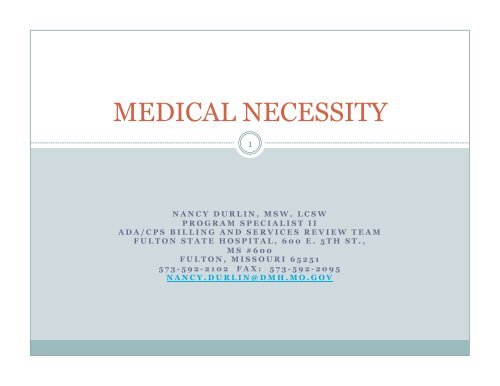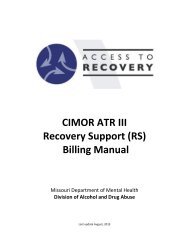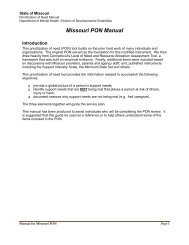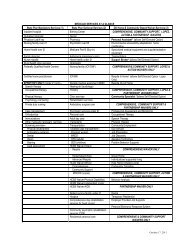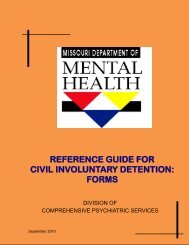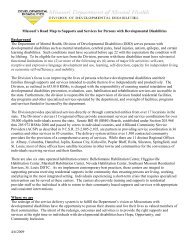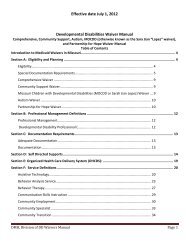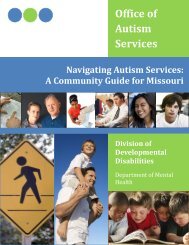Medical necessity and person centered planning
Medical necessity and person centered planning
Medical necessity and person centered planning
You also want an ePaper? Increase the reach of your titles
YUMPU automatically turns print PDFs into web optimized ePapers that Google loves.
MEDICAL NECESSITY<br />
1<br />
NANCY DURLIN, MSW, LCSW<br />
PROGRAM SPECIALIST II<br />
ADA/CPS BILLING AND SERVICES REVIEW TEAM<br />
FULTON STATE HOSPITAL, 600 E. 5TH ST.,<br />
MS #600<br />
FULTON, MISSOURI 65251<br />
573-592-2102 FAX: 573-592-2095<br />
NANCY.DURLIN@DMH.MO.GOV
MENTAL ILLNESS<br />
2<br />
Mental illness is a medical<br />
condition.
REVIEW PROCESS<br />
3<br />
When reviewing documentation to<br />
determine whether the services provided are<br />
medically necessary, we look to the<br />
assessment to confirm eligibility for the level<br />
of services being provided, <strong>and</strong> the<br />
identification of functional deficits <strong>and</strong><br />
needs. Once we are assured that the <strong>person</strong><br />
being served is eligible, we look at the<br />
<strong>person</strong>’s stated preferences, strengths,<br />
assets, challenges <strong>and</strong> resources.
INDIVIDUAL TREATMENT PLAN<br />
The <strong>person</strong> receiving services participates in<br />
the development of their individual<br />
treatment plan, integrating their hopes <strong>and</strong><br />
dreams into the outcomes/goals.<br />
Assets are identified.<br />
Obstacles are identified.<br />
Resources are identified.<br />
4
SPECIFIC VERSUS GENERIC<br />
The assets, obstacles <strong>and</strong> resources are not<br />
generic, but are <strong>person</strong> <strong>and</strong> outcome<br />
specific. A different description of assets,<br />
obstacles <strong>and</strong> resources may relate to each<br />
outcome on the treatment plan; however,<br />
several may be more global <strong>and</strong> relate to<br />
several or all outcomes.<br />
5
ITP Objectives<br />
Objectives are <strong>person</strong>-<strong>centered</strong> <strong>and</strong> measurable.<br />
6
INTERVENTIONS<br />
Interventions are descriptive of supports that<br />
will be provided, including frequency,<br />
duration, target dates <strong>and</strong> the title of<br />
<strong>person</strong>s who may provide the supports.<br />
Interventions should relate back to the<br />
needs identified on the assessment.<br />
7
ITP REVIEWS<br />
Reviews are performed at regular intervals,<br />
including ITP changes which support the<br />
individual’s progress in recovery.<br />
8
Service Plans- Common Mistakes<br />
• Person served does not appear to be involved in the<br />
plan or process<br />
• Outcomes/Goals are not recovery oriented<br />
• No <strong>person</strong>-first language<br />
• Generic assets/strengths: non-specific to goals,<br />
objectives & interventions<br />
• Generic goals & objectives: not individualized to<br />
<strong>person</strong> being served<br />
• Goals & objectives in clinical language/terms which<br />
are generic <strong>and</strong> meaningless to the <strong>person</strong> being<br />
served<br />
9
PROGRESS NOTES<br />
All services provided by an agency should be recorded<br />
in the medical record, whether they are billable or<br />
not.<br />
Progress notes report services provided, as prescribed<br />
by the ITP, <strong>and</strong> address needs identified in the<br />
assessment.<br />
10
LACKS MEDICAL NECESSITY<br />
Examples of documentation that lack medical <strong>necessity</strong>: (the<br />
missing piece)<br />
The amount of time billed for a service or intervention is in excess of a<br />
range of what would be expected based upon the treatment plan,<br />
evaluation or other documentation.<br />
11<br />
The assessment or evaluation may not have identified a need for service<br />
(s)<br />
Providing service that appears routine, r<strong>and</strong>om, unplanned, or<br />
unnecessary<br />
Providing service simply because the <strong>person</strong> served requested<br />
Service provided is not within st<strong>and</strong>ard or accepted practice guidelines<br />
<strong>and</strong> lacks clinical justification or approved exception<br />
<br />
Service lacked clinical justification of need
THE GOLDEN THREAD<br />
12<br />
Ensure that <strong>Medical</strong> Necessity pieces fit -- Clear<br />
identification <strong>and</strong> association between the deficits/<br />
needs in assessment, service plan, <strong>and</strong> progress<br />
notes.


